Gov. Paterson Gives the GOP Three Gifts
By Sean TrendeOne of the most hotly debated questions surrounding the elections held from 2005 to 2008 is whether they represented a rejection of conservatism, of Republicans, or merely of President George W. Bush. Republicans and conservatives hoped and argued that the latter factor was the predominant one in the back-to-back GOP routs, and that Republicans would bounce back relatively quickly after President Bush exited the national stage.
This view gained some currency in the immediate aftermath of the 2008 elections. Republican Saxby Chambliss won a special election in Georgia by a hefty margin that looked much more like a "normal" Republican victory margin in Georgia than did his three-point lead on Election Day. In a subsequent special election, Republicans held a seat in Northwest Louisiana that was similar to other Southern seats in which they had recently been losing. They also defeated scandal-tarred Rep. William Jefferson in his heavily Democratic district.
While it is dangerous to read too much into special election results of any kind, these "normal" looking results gave some hope to Republicans that their long nightmare was over, and that dissatisfaction with Republicans was dissipating. Now, David Paterson has given Republicans a golden opportunity to lend further credence to this interpretation. By appointing sophomore Representative Kirsten Gillibrand to the Senate seat vacated by now-Secretary of State Hillary Clinton, Governor Paterson has given three gifts to the New York GOP: He has opened up a district that is likely to flip back to them, he has made a much more competitive race for the Senate seat than there otherwise would have been, and he has appointed the most conservative Democrat to the seat.
The appointment of Gillibrand to the Senate opens up New York's Twentieth Congressional District, a district that Republicans should win in a normal year. The New York Republican delegation has been hard hit by the Democratic trend of the country over the past several years. Through a combination of scandal, incompetence, and bad luck, since 2002 Republicans have lost seven seats in the delegation, which swung from a 19-10 Democratic edge to a 26-3 Democratic edge. This is illustrated graphically in the maps below, which compare the New York maps from 2002 and 2008.
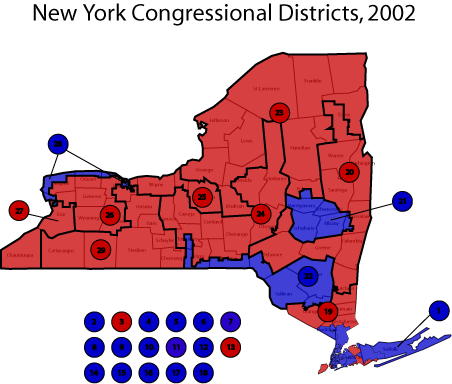
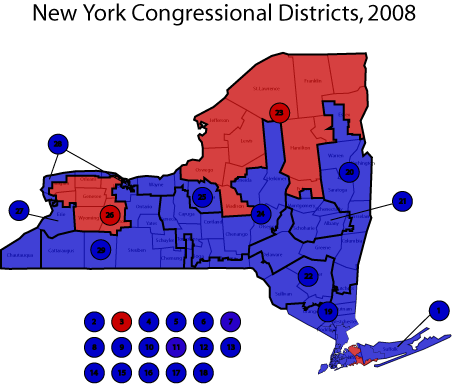
While the districts in upstate New York are traditionally Republican, the twentieth district is one of the most consistent Republican districts. Tracing its pedigree is difficult, since for much of the nineteenth and twentieth centuries upstate New York had around twenty Congressional Districts, versus the eleven it has today. From 1872 until 1912, the four districts that cover the territory of the present Twentieth District elected two Democrats to Congress, one in 1882 and one in 1910. In the map below, which shows the New York delegation in 1902, these districts are represented by the 21st, 22nd, 24th and 25th districts (remember, prior to the mid-1960s, the one-person-one-vote standard was not in effect, so districts changed shape much less frequently than they do today):
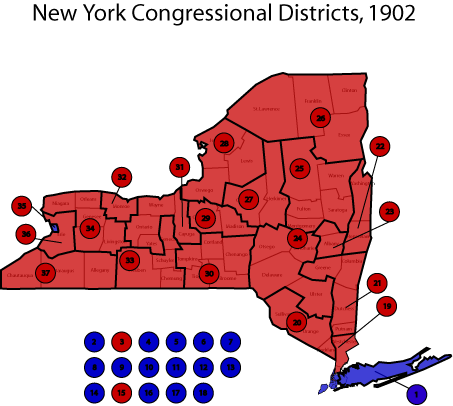
From 1912 until 1972, most of the present district was covered by two Congressional districts. During this stretch, the southern district elected a Democrat in 1912 and 1914, and once in 1964 and 1966. A good view of these districts is seen in the map from the mid-decade redistricting of 1970 (which was aimed at eliminating Congressman Allard Lowenstein):
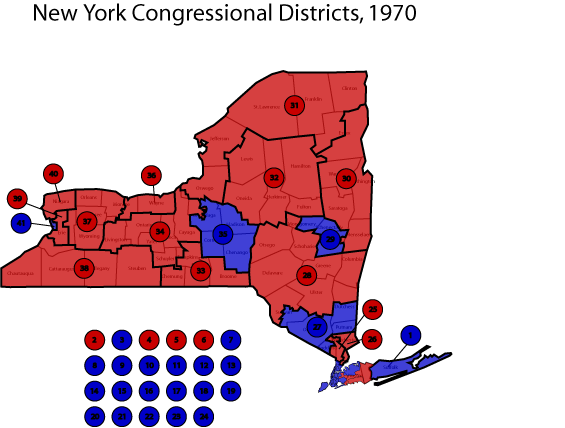
In 1972, a district that resembles the present twentieth was born, although it was numbered the twenty-ninth. In 1974 it elected a young liberal Congressman named Ned Pattison. He was re-elected in 1976 in a three-way race against a Republican candidate and a Conservative party candidate, but was beaten in 1978 by Gerald Solomon. In 2006 Solomon's successor, John Sweeney, lost to Gillibrand by six points. Most polls had shown Sweeney leading Gillibrand, until he was battered by a barrage of negative publicity, including allegations of domestic abuse, photographs surfacing of the Congressman at a fraternity party, and an aggravated DWI charge.
The bottom line is that the district historically only elects Democrats in the worst of circumstances for Republicans. The election of Gillibrand was no exception, and it is not accidental that she strove to compile a moderate voting record. The question, then, is whether we can expect this historic trend to continue now that the seat is open. There is little doubt that upstate New York is less Republican than before - one need only to look at the map from 2008 above to confirm that. But reports of the Republicans' death here are greatly exaggerated. While the district is considered R+3 in the Cook Partisan Voting Index (meaning it voted three points more Republican at the Presidential level than the rest of the country), those ratings often fail to pick up subtle nuances of local politics.
Consider the following two maps, which show the representation for the state houses within and around the 20th Congressional District:
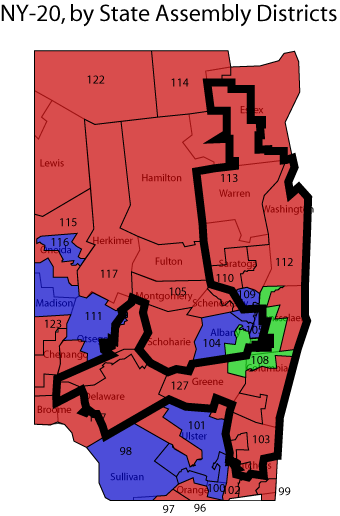
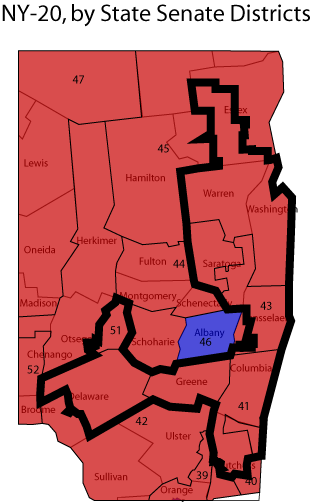
Although the district may not be crazy about Republicans who head national tickets, at the state level it still elects almost exclusively Republicans (the green district is represented by an Independence party candidate). This gives Republicans a deep bench in the district. Moreover, it indicates that the district is probably more Republican than its vote at the Presidential level would indicate - in this regard it may be a more conservative version of MA-05, which came close to sending a Republican to Congress in 2007 despite having voted for John Kerry by nearly twenty points three years earlier.
The field has not yet shaped up, but the parties will determine their nominee through a Byzantine weighted county voting system. The winner will face off in a yet-to-be-scheduled general election. This is a race that the GOP should win; if it does, it could give some much needed momentum for the party. Moreover, if the race looks like a typical race here, with the GOP winning by close to double digits, it would be another data point that shows that national politics has moved to a "normal" balance. But if the GOP loses, the results could indicate that the dissatisfaction with the GOP runs much deeper than dissatisfaction with the forty-third President, and that the damage will be long-lasting. Again, one should always be wary of reading too much into special elections, which are all sui generis to some extent.
Two other smaller gifts were handed to the GOP by Governor Paterson as well. As rumors of Gillibrand's appointment began to swirl, Fourth District representative and NRA arch-nemesis Carolyn McCarthy indicated that she would challenge the NRA-friendly Gillibrand in the 2010 primary. Other Democrats also have expressed interest in the seat. A nasty Democratic primary could - and I emphasize could - damage the Democrat's eventual candidate and perhaps make it difficult to unify the party.
This does not mean that the GOP's odds of winning the Senate seat are as strong as their odds of winning the House seat. But it does turn an out-of-reach Senate seat into a long shot. The GOP has a strong potential candidate in Rep. Peter King, whose base in the New York City suburbs gives him a chance at replicating the Long Island/Upstate connection which is the key to Republican success. Much will ultimately depend on the fate of the Obama administration and where its public approval stands in November of 2010. But the appointment of Gillibrand and the likely primary puts the seat of President Obama's Secretary of State closer to being within the GOP's reach.
Lastly, the fact that Paterson appointed the most conservative Democrat from New York in effect means that the GOP is gaining the closest thing to a Senate seat it could have expected from this appointment. Gillibrand's Poole-Rosenthal NOMINATE score (which is taken from all roll call votes in a given Congress) places her as the eighteenth most conservative Democrat in the last Congress, right between Dan Boren and Mike McIntyre. If her voting record stays consistent (and it may well not), she would arguably have the second most conservative voting record of any New York Senator since the early 1900s. Even if she responds to representing a statewide constituency that is less Saratoga and more SoHo by moving to the left, something that will most likely happen, her voting record will probably still be to the right of any other New York politician that Paterson could have appointed.
In the end, the first two gifts will likely prove fleeting: The Twentieth will likely be eliminated in redistricting in 2010 (assuming that Democrats still control the Governor's mansion and both state houses), and Gillibrand will likely survive the primary and the general. Because of this, the last gift is likely to give the GOP the longest-lasting benefit. Gillibrand would have had a difficult time winning a primary on her own; by appointing the 42-year-old Gillibrand to the seat, Paterson may have given the GOP the best Senator from New York for whom it could have hoped.




No comments:
Post a Comment